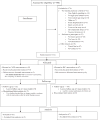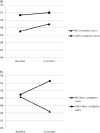Counselor-assisted problem solving improves caregiver efficacy following adolescent brain injury
- PMID: 24611923
- PMCID: PMC4461433
- DOI: 10.1037/a0034911
Counselor-assisted problem solving improves caregiver efficacy following adolescent brain injury
Abstract
Purpose: The purpose of the current study is to examine the efficacy of Counselor-Assisted Problem Solving (CAPS) in improving caregiver adaptation following traumatic brain injury (TBI).
Research method/design: In a randomized clinical trial comparing CAPS (n = 65), an online problem-solving intervention with accompanying Web-based counseling sessions, with an information-based Internet Resource Comparison (IRC; n = 67) program, participants included families of 12- to 17-year-olds who had sustained a TBI in the past 6 months. Linear regression analyses were used to identify main effects and to examine whether caregiver education, race, or prior computer use moderated treatment efficacy.
Results: Computer experience moderated postintervention improvements in caregiving self-efficacy following CAPS, Specifically, parents in CAPS with low levels of prior use reporting the greatest improvements. CAPS participants who completed 5 or more sessions reported greater reductions in depression than did the IRC; however, the groups did not differ on global distress.
Conclusions/implications: Findings support the potential utility of counselor-supported Web-based interventions particularly for individuals with limited computer expertise following adolescent TBI.
PsycINFO Database Record (c) 2014 APA, all rights reserved.
Figures
References
-
- Boothroyd RA, Evans ME. Preliminary manual for the caregiver self-efficacy scale. Tampa, FL: Department of Mental Health Law and Policy, University of South Florida; 1997.
-
- Derogatis LR, Lazarus L. SCL-90-R, brief symptom inventory, and matching clinical rating scales. In: Maruish M, editor. The use of psychological testing for treatment planning and outcome assessment. Hillsdale, NJ: Erlbaum; 1994. pp. 217–248.
-
- D’Zurilla TJ, Nezu AM. Problem-solving therapies. In: Dobson KS, editor. Handbook of cognitive– behavioral therapies. 3. New York, NY: Guilford Press; 2006. pp. 211–245.
Publication types
MeSH terms
Grants and funding
LinkOut - more resources
Full Text Sources
Other Literature Sources
Medical
Miscellaneous



